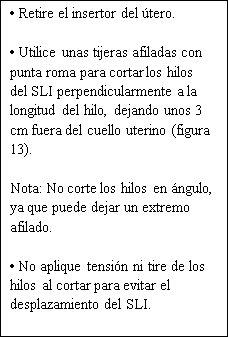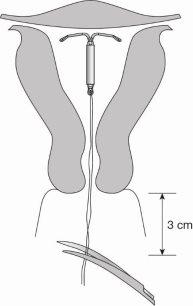
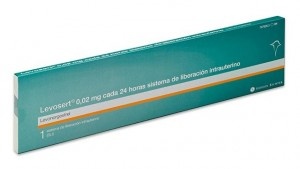
ЛЕВОСЕРТ ОДИН 0,02 мг КАЖДЫЕ 24 ЧАСА ВНУТРИМАТЕРОЧНАЯ СИСТЕМА ПРОДОЛЖИТЕЛЬНОГО ВЫСВОБОЖДЕНИЯ


Инструкция по применению ЛЕВОСЕРТ ОДИН 0,02 мг КАЖДЫЕ 24 ЧАСА ВНУТРИМАТЕРОЧНАЯ СИСТЕМА ПРОДОЛЖИТЕЛЬНОГО ВЫСВОБОЖДЕНИЯ
Введение
Инструкция: Информация для пациентки
Левосерт Оне0,02 мг каждые 24 часа система внутриматочной доставки
левоноргестрел
Прочитайте внимательно всю инструкцию перед началом использования этого лекарства, поскольку она содержит важную информацию для вас.Важно прочитать инструкцию перед началом использования.
- Сохраните эту инструкцию, поскольку вам может потребоваться прочитать ее снова.
- Если у вас есть какие-либо вопросы, проконсультируйтесь с вашим врачом или фармацевтом.
- Если вы испытываете побочные эффекты, проконсультируйтесь с вашим врачом или фармацевтом, даже если это побочные эффекты, которые не указаны в этой инструкции. См. раздел 4.
Содержание инструкции
- Что такое Левосерт Оне и для чего он используется
- Что вам нужно знать перед началом использования Левосерт Оне
- Как использовать Левосерт Оне
- Возможные побочные эффекты
5 Хранение Левосерт Оне
- Содержание упаковки и дополнительная информация
1. Что такое Левосерт Оне и для чего он используется
Это лекарство является системой внутриматочной доставки (СВД) для введения в матку, где оно медленно выделяет гормон левоноргестрел.
Он используется для:
Контрацепции
Это лекарство является эффективным, длительным, но не постоянным (реверсивным) методом контрацепции.
Это лекарство предотвращает беременность, делая более тонким слизистую оболочку матки (эндометрий), увеличивая толщину нормальной слизи шейки матки, так что сперматозоиды не могут проникнуть через нее для оплодотворения яйцеклетки, и предотвращая овуляцию у некоторых женщин. Кроме того, присутствие Т-образного корпуса оказывает местные эффекты на слизистую оболочку матки.
Систему необходимо удалить после 8 лет использования, когда она используется как контрацептив.
Лечение обильных менструальных кровотечений
Это лекарство также полезно для уменьшения менструальных кровотечений, поэтому его можно использовать, если у вас обильные менструальные кровотечения (меноррагия). Гормон в этом лекарстве действует, делая более тонким слизистую оболочку матки, так что кровотечений становится меньше каждый месяц.
Систему необходимо удалить или заменить после 8 лет использования или раньше, если обильные менструальные кровотечения возобновляются или становятся неприятными.
Дети и подростки
Это лекарство не предназначено для использования до первой менструации (менархе).
2. Что вам нужно знать перед началом использования Левосерт Оне
Не используйте Левосерт Оне
- если вы беременны или подозреваете, что можете быть беременной;
- если у вас есть или была воспалительная болезнь тазовых органов;
- если у вас есть необычные или неприятные вагинальные выделения, или зуд влагалища, поскольку это может указывать на инфекцию;
- если у вас есть или была воспаление слизистой оболочки матки после родов;
- у вас есть или была инфекция матки после родов или после аборта в течение последних 3 месяцев;
- если у вас есть или была воспаление шейки матки;
- если у вас есть или была аномальный результат теста Папаниколау (изменения шейки матки);
- если у вас есть или была проблема с печенью;
- если у вас есть опухоль печени;
- если у вас есть аномалия матки, включая миому матки, особенно если она искажает полость матки;
- если у вас есть аномальный вагинальный кровотечения;
- если у вас есть состояние, которое делает вас восприимчивым к инфекциям. Врач сообщит вам, если у вас есть такое состояние;
- если у вас есть или была гормонозависимый рак, такой как рак молочной железы;
- если у вас есть или была подозрение на любой тип рака, включая рак крови (лейкемию), матки и шейки матки, если только вы не находитесь в стадии ремиссии;
- если у вас есть или была трофобластическая болезнь. Врач сообщит вам, если у вас есть такое состояние;
- если вы аллергичны к левоноргестрелу или любому другому компоненту этого лекарства (перечисленному в разделе 6).
Предостережения и меры предосторожности
Прежде чем это лекарство будет введено, ваш врач или медсестра проведут некоторые тесты, чтобы убедиться, что это лекарство подходит для вас. Это будет включать в себя гинекологический осмотр и может включать другие тесты, такие как осмотр груди, если ваш врач или медсестра считают это подходящим.
Генитальные инфекции должны быть успешно лечены до введения этого лекарства.
Если у вас есть эпилепсия, сообщите об этом врачу или медсестре перед введением этого лекарства, поскольку, хотя это редко, может произойти приступ во время введения. Некоторые женщины могут чувствовать, что они теряют сознание после процедуры. Это нормально, и ваш врач или медсестра скажут вам отдохнуть немного.
Это лекарство может не подходить для всех женщин.
Это лекарство, как и другие гормональные контрацептивы, не защищает от инфекции ВИЧ (СПИД) или от любой другой болезни, передающейся половым путем (например, хламидиоз, генитальный герпес, генитальные бородавки, гонорея, гепатит Б и сифилис). Вам понадобятся презервативы, чтобы защититься от этих заболеваний.
Поговорите с вашим врачом перед использованием Левосерт Оне:
- если у вас есть или развивается мигрень, головокружение, размытое зрение, более сильные головные боли, чем обычно, или если у вас часто бывают головные боли;
- если у вас желтуха кожи или белого глаза (желтуха);
- если вы диабетик (слишком высокий уровень сахара в крови), у вас высокое кровяное давление или аномальные уровни липидов в крови;
- если у вас был рак, влияющий на кровь (включая лейкемию), который сейчас находится в стадии ремиссии
- вы проходите длительное лечение стероидами;
- если у вас был внешний беременность (развитие плода вне матки) или история овариальных кист;
- если у вас была тяжелая артериальная болезнь, такая как инфаркт или инсульт;
- если у вас есть история тромбозов;
- если вы принимаете другие лекарства, поскольку некоторые лекарства могут предотвратить правильное действие этого лекарства;
- если у вас есть нерегулярные кровотечения;
- если у вас есть приступы (эпилепсия).
Если у вас есть или была любое из этих состояний, ваш врач решит, можете ли вы использовать это лекарство.
Также необходимо сообщить врачу, если любое из этих состояний возникает впервые, пока у вас введено это лекарство.
Вам следует как можно скорее обратиться к врачу или медсестре, если у вас есть болезненное опухание ноги, внезапная боль в груди или трудности с дыханием, поскольку это могут быть признаки тромбоза. Важно немедленно лечить любой тромбоз.
Исключение
Маточные сокращения во время менструации иногда могут вытолкнуть СВД из его положения или исключить его. Это более вероятно, если у вас избыточный вес на момент введения СВД или если у вас история обильных менструаций. Если СВД выйдет из положения, оно может не работать правильно, и, следовательно, риск беременности увеличивается. Если СВД исключается, вы больше не защищены от беременности.
Возможные симптомы исключения - боль и аномальное кровотечение, но Левосерт Оне также может быть исключен без вашего ведома. Поскольку Левосерт Оне уменьшает менструальное кровотечение, увеличение кровотечения может быть указанием на исключение.
Рекомендуется проверять нити пальцами, например, во время душа. См. также раздел 3 «Как использовать Левосерт Оне - Как я могу знать, что Левосерт Оне правильно введен?». Если вы заметите признаки исключения или не сможете прощупать нити, вам следует использовать дополнительный метод контрацепции (например, презервативы) и проконсультироваться с вашим медицинским специалистом.
Психиатрические расстройства:
Некоторые женщины, использующие гормональные контрацептивы, такие как это лекарство, сообщили о депрессии или депрессивном состоянии. Депрессия может быть тяжелой и иногда может вызывать суицидальные мысли. Если вы испытываете изменения настроения и депрессивные симптомы, обратитесь к врачу за дополнительной медицинской консультацией как можно скорее.
Это лекарство и курение
Рекомендуется женщинам бросить курить. Курение увеличивает риск развития инфаркта, инсульта или тромбоза.
Использование тампонов и менструальных чаш
Рекомендуется использовать прокладки. Если используются тампоны или менструальные чашки, необходимо осторожно менять их, чтобы не потянуть за нити удаления Левосерт Оне.
Другие лекарства и Левосерт Оне
Эффект гормональных контрацептивов, таких как это лекарство, может быть уменьшен лекарствами, которые увеличивают количество ферментов, производимых печенью. Сообщите врачу, если вы принимаете:
- фенобарбитал, фенитоин или карбамазепин (для лечения эпилепсии);
- гризеофульвин (антифунгальный препарат);
- рифампицин или рифабутин (антибиотики);
- невирапин или эфавиренз (для ВИЧ).
Сообщите врачу, если вы принимаете, недавно принимали или можете принимать любое другое лекарство. Это лекарство не должно использоваться одновременно с другим гормональным контрацептивом.
Беременность, лактация и фертильность
Не используйте это лекарство во время беременности или если подозреваете, что можете быть беременной.
Могу ли я забеременеть, используя это лекарство?
Очень редко женщина может забеременеть, имея введенный этот прибор.
Отсутствие менструации не обязательно означает, что вы беременны. Некоторые женщины могут не иметь менструаций, используя систему.
Если у вас не было менструации в течение 6 недель, рассмотрите возможность сделать тест на беременность. Если он отрицательный, нет необходимости делать больше тестов, если только у вас нет других симптомов беременности, таких как тошнота, усталость или чувствительность груди.
Если вы забеременели с устройством, введенным, обратитесь к врачу как можно скорее, чтобы исключить внешнюю беременность (развитие плода вне матки) и чтобы удалить это лекарство, чтобы уменьшить риск спонтанного аборта. Однако, если Левосерт Оне остается введенным во время беременности, это не только увеличивает риск спонтанного аборта, но и риск преждевременных родов. Если Левосерт Оне не может быть удален, поговорите с вашим медицинским специалистом о преимуществах и рисках продолжения беременности. Если беременность продолжается, вы будете внимательно отслеживаться во время беременности и должны немедленно обратиться к врачу, если испытываете боли в животе, боли в животе или лихорадку.
Левосерт Оне содержит гормон левоноргестрел, и были единичные случаи генитальных эффектов у младенцев, если они подвергались воздействию внутриматочных устройств с левоноргестрелом, находясь в матке.
А что, если я хочу иметь ребенка?
Если вы хотите иметь ребенка, попросите врача удалить это лекарство. Ваш нормальный уровень фертильности быстро восстановится после удаления системы.
Могу ли я кормить грудью, используя это лекарство?
В грудном молоке содержатся очень небольшие количества гормона этого лекарства. Не ожидается, что это будет представлять какой-либо риск для новорожденного. Вы можете продолжать кормить грудью во время использования этого лекарства.
Вождение и использование машин
Не известно никаких эффектов на способность управлять транспортными средствами и использовать машины.
Левосерт Оне содержит сульфат бария
Т-образная структура этого лекарства содержит сульфат бария, который делает его видимым на рентгеновских снимках.
3. Как использовать Левосерт Оне
Только врач или медсестра с специальной подготовкой могут вставить систему (см. специальные инструкции для вставки в упаковке).
Врач объяснит вам процедуру вставки и любые риски, связанные с ее использованием. После этого вас осмотрит ваш врач или медсестра перед вставкой этого препарата. Если у вас есть какие-либо вопросы о его использовании, вы можете проконсультироваться с ними.
Начало использования Левосерт Оне
- Прежде чем вставить Левосерт Оне, необходимо убедиться, что вы не беременны.
- Вам следует вставить Левосерт Оне в течение 7 дней после начала менструации. Когда Левосерт Оне вставляется в эти дни, он начинает действовать сразу и предотвратит беременность.
- Если вы не можете вставить Левосерт Оне в течение 7 дней после начала менструации или если ваш менструальный цикл наступает в непредсказуемое время, Левосерт Оне можно вставить в любой другой день. В этом случае вы не должны были иметь незащищенные половые контакты с момента последней менструации, и вам необходимо пройти тест на беременность перед вставкой. Кроме того, Левосерт Оне может не предотвратить беременность надежно сразу. Следовательно, вам необходимо использовать метод барьерной контрацепции (например, презервативы) или воздержаться от вагинальных половых контактов в течение первых 7 дней после вставки Левосерт Оне.
- Левосерт Оне не подходит для использования в качестве экстренной контрацепции (послекоитальной контрацепции).
Начало использования Левосерт Оне после родов
- Левосерт Оне можно вставить после родов, как только матка вернется к своему нормальному размеру, но не раньше чем через 6 недель после родов (см. раздел 4 «Возможные побочные эффекты – Перфорация»).
- См. также «Начало использования Левосерт Оне» выше, чтобы узнать, что еще вам необходимо знать о моменте вставки.
Начало использования Левосерт Оне после аборта
Левосерт Оне можно вставить сразу после аборта, если беременность была менее 3 месяцев и нет генитальных инфекций. Тогда Левосерт Оне начнет действовать сразу.
Замена Левосерт Оне
Левосерт Оне можно заменить новым Левосерт Оне в любой момент менструального цикла. Тогда Левосерт Оне начнет действовать сразу.
Смена другого метода контрацепции (например, гормональных контрацептивов, имплантата)
- Левосерт Оне можно вставить сразу, если есть разумная уверенность, что вы не беременны.
- Если прошло более 7 дней с момента начала менструального кровотечения, вам необходимо воздержаться от вагинальных половых контактов или использовать дополнительную контрацепцию в течение следующих 7 дней.
Вставка Левосерт Оне
Осмотр, проведенный вашим медицинским специалистом перед вставкой, может включать:
- тест на цитологию шейки матки (мазок Папаниколау);
- осмотр молочных желез;
- другие тесты, например, на инфекции, включая заболевания, передающиеся половым путем, тест на беременность, по мере необходимости. Ваш медицинский специалист также проведет гинекологический осмотр, чтобы определить положение и размер матки.
После гинекологического осмотра
- Инструмент, называемый спекулумом, вводится во влагалище, и шейка матки может быть очищена антисептическим раствором. Затем Левосерт Оне вставляется в матку с помощью тонкой и гибкой пластиковой трубки (трубки для вставки). Можно применить местную анестезию на шейке матки перед вставкой.
- Некоторые женщины чувствуют головокружение или теряют сознание во время вставки или после того, как Левосерт Оне был вставлен или удален.
- Вы можете испытать некоторый дискомфорт и кровотечение во время или сразу после вставки.
После вставки Левосерт Оне вам должна быть выдана карта напоминания для пациента от вашего врача для плановых осмотров. Возьмите эту карту с собой на каждую запланированную встречу.
С какой скоростью действует Левосерт Оне?
Контрацепция
Если Левосерт вставляется в вашу матку во время менструации или в течение 7 дней после начала менструации, или если у вас есть устройство и пора его заменить на новое, или если вы только что сделали аборт, вы защищены от беременности с момента вставки системы.
Обильное менструальное кровотечение
Этот препарат обычно достигает значительного уменьшения потери менструальной крови в течение 3-6 месяцев лечения.
Как Левосерт Оне повлияет на мои менструации?
Многие женщины испытывают пятна (небольшую потерю крови) в течение первых 3-6 месяцев после вставки системы. Другие могут иметь длительные или обильные кровотечения. Однако вы можете испытать увеличение кровотечения, обычно в течение первых 2-3 месяцев, прежде чем будет достигнуто уменьшение потери крови. В целом, у вас больше шансов иметь меньше дней кровотечения каждый месяц, и вы даже можете перестать иметь менструацию. Это связано с действием гормона (левоноргестрела) на слизистую оболочку матки. Если не будет достигнуто заметного уменьшения потери крови в течение 3-6 месяцев, следует рассмотреть другие методы лечения.
Если вам вставили этот препарат давно и затем у вас начались проблемы с кровотечением, обратитесь к вашему врачу или медицинскому специалисту за советом.
С какой частотой мне следует проверять систему?
Вам следует проверить Левосерт Оне через 4-6 недель после вставки и затем регулярно,至少 один раз в год до его удаления. Ваш врач сможет определить, с какой частотой и какие типы осмотров необходимы в вашем конкретном случае. Возьмите карту напоминания для пациента, которую вы получили от вашего врача, на каждую запланированную встречу. Кроме того, вам следует обратиться к вашему врачу, если у вас出现ят какие-либо из симптомов, описанных в разделе 2 «Предостережения и меры предосторожности».
Как я могу знать, что система находится на месте?
После каждой менструации вы можете искать два тонких нити, прикрепленных к нижнему концу системы. Ваш врач покажет вам, как это сделать.
Не тянитеза нити, поскольку вы можете случайно удалить систему. Если вы не можете найти нити, обратитесь к вашему врачу или медсестре как можно скорее и избегайте половых контактов или используйте метод барьерной контрацепции (например, презервативы) до тех пор, пока не будете осмотрены. Возможно, нити просто вошли в матку или шейку матки. Если ваш врач или медсестра не могут найти нити, они могли сломаться, или система могла быть удалена сама собой, или в редких случаях могло произойти прободение стенки матки (перфорация матки, см. раздел 4).
Вам также следует обратиться к врачу, если вы можете прикоснуться к нижнему концу устройства или если вы или ваш партнер испытываете боль или дискомфорт во время половых контактов.
Если система полностью или частично удалена, вы можете не быть защищены от беременности. Редко, но возможно, это может произойти без вашего ведома во время менструации. Необычное увеличение количества кровотечения во время менструации может быть признаком того, что это произошло. Сообщите вашему врачу или медицинскому специалисту, если у вас出现ят непредвиденные изменения в паттерне кровотечения.
Удаление Левосерт Оне
Левосерт Оне должен быть удален или заменен после 8 лет использования или раньше, если возобновляется обильное или неприятное менструальное кровотечение.
Ваш врач может легко удалить систему в любой момент, после чего вы можете забеременеть. Некоторые женщины чувствуют головокружение или теряют сознание во время или после удаления Левосерт Оне. Вы можете испытать некоторый дискомфорт и кровотечение во время удаления Левосерт Оне.
Продолжение контрацепции после удаления
Если вы не хотите забеременеть, Левосерт Оне не должен быть удален после 7-го дня менструального цикла (менструации), если только вы не будете использовать другие методы контрацепции (например, презервативы) в течение至少 7 дней до удаления системы.
Если у вас есть нерегулярные менструации или вы не имеете менструаций, вам следует использовать метод барьерной контрацепции в течение 7 дней до удаления.
Кроме того, новый Левосерт Оне можно вставить сразу после удаления, в этом случае не требуется дополнительная защита. Если вы не хотите продолжать использовать тот же метод, спросите вашего врача о других надежных методах контрацепции.
Если у вас есть дальнейшие вопросы о использовании этого препарата, спросите вашего врача.
4. Возможные побочные эффекты
Как и все лекарства, этот препарат может вызывать побочные эффекты, хотя не все люди испытывают их.
С этим препаратом побочные эффекты чаще всего встречаются в течение первых месяцев после вставки системы и уменьшаются с течением времени.
Если вы испытываете любой из следующих серьезных побочных эффектов, пожалуйста, обратитесь к вашему врачу или медсестре немедленно:
- Сильная боль или лихорадка, развивающаяся вскоре после вставкиможет указывать на то, что у вас есть серьезная инфекция, которую необходимо лечить немедленно. В редких случаях может произойти очень серьезная инфекция (сепсис).
- Сильная боль и постоянное кровотечениемогут быть признаком повреждения или разрыва стенки матки (перфорации). Перфорация редка, но чаще всего происходит во время вставки препарата, хотя может не быть обнаружена до некоторого времени после этого. Если препарат находится вне полости матки, он не эффективен для предотвращения беременности и должен быть удален как можно скорее; в очень редких случаях это может потребовать хирургического вмешательства. Риск перфорации низок, но увеличивается у женщин в период лактации или у женщин, которые родили ребенка до 36 недель до вставки, и может увеличиться у женщин с фиксированной маткой, наклоненной назад (ретроверсия и фиксация матки). Если вы подозреваете, что могли испытать перфорацию, немедленно обратитесь за медицинской помощью и сообщите, что у вас вставлен этот препарат, особенно если это не был человек, который его вставил.
Возможные признаки и симптомы перфорации могут включать:
- сильную боль (как менструальные спазмы) или более сильную боль, чем ожидается
- обильное кровотечение (после вставки)
- боль или кровотечение, продолжающееся более нескольких недель
- внезапные изменения менструаций
- боль во время половых контактов
- если вы больше не можете чувствовать нити препарата (см. раздел 3 «Как использовать Левосерт Оне» «Как я могу знать, что система находится на месте?»).
- Боль в нижней части живота, особенно если у вас также есть лихорадка или вы имели пропуск или имеете непредвиденное кровотечение,может быть признаком внематочной беременности (развития плода вне матки). Абсолютный риск внематочной беременности у пользователей этого препарата низок. Однако, когда женщина забеременеет с этим препаратом внутри, вероятность внематочной беременности увеличивается.
- Боль в нижней части живота или вы испытываете трудные или болезненные половые контактыможет быть признаком овариальных кист или воспалительного заболевания тазовых органов. Это важно, поскольку воспалительные заболевания тазовых органов могут уменьшить ваши шансы на беременность и могут увеличить риск внематочной беременности.
Другие побочные эффекты
Очень часто(могут возникать у более 1 из 10 женщин) могут включать:
- отсутствие менструаций, легкие или редкие (см. «Как Левосерт Оне повлияет на мои менструации?» в разделе 3.
- вагинальное кровотечение, включая пятна.
- вагинальные и генитальные инфекции (вульва), вызванные грибами или бактериями;
- прыщи (акне);
Часто(могут возникать у до 1 из 10 женщин) могут включать:
- депрессию, нервозность или другие изменения настроения;
- уменьшение сексуального влечения;
- головную боль;
- мигрень;
- чувство обморока (предобморочное состояние);
- головокружение;
- боль в спине;
- абдоминальный дискомфорт;
- тошноту;
- вздутие живота;
- рвоту;
- болезненные менструации;
- увеличение вагинального выделения;
- чувствительные и болезненные груди;
- спазм матки;
- система удаляется из места;
- прибавка в весе.
Редко(могут возникать у до 1 из 100 женщин) могут включать:
- обморок;
- экзему;
- воспаление шейки матки (цервцит);
- отек или воспаление в ногах или лодыжках;
- увеличение роста волос на лице и теле;
- потеря волос;
- зуд кожи (прурит);
- пигментация кожи или увеличение пигментации кожи, особенно на лице (хлоазма).
Мало(могут возникать у до 1 из 1000 женщин) могут включать:
- кожную сыпь, зуд.
Сообщение о побочных эффектах
Если вы испытываете побочные эффекты, проконсультируйтесь с вашим врачом или фармацевтом, даже если это возможные побочные эффекты, которые не перечислены в этом листке инструкции. Вы также можете сообщить о них напрямую через систему фармакологического надзора за лекарствами для человека: www.notificaram.es. Сообщая о побочных эффектах, вы можете внести свой вклад в предоставление более полной информации о безопасности этого препарата.
5. Хранение Левосерт Оне
Этот препарат не требует специальных условий хранения.
Хранить в оригинальной упаковке и держать блистер запечатанным в наружной коробке, чтобы защитить его от света.
Держать упаковку плотно закрытой. Только ваш врач или медицинский специалист должны ее открывать.
Держать этот препарат вне поля зрения и досягаемости детей.
Не используйте этот препарат после даты истечения срока годности, указанной на этикетке и коробке после «CAD». Дата истечения срока годности – последний день месяца, указанного.
Лекарства не должны выбрасываться в канализацию или мусор. Поместите упаковку и лекарства, которые вам больше не нужны, в пункт SIGRE аптеки. Если у вас есть сомнения, спросите вашего фармацевта, как избавиться от упаковки и лекарств, которые вам больше не нужны. Таким образом, вы поможете защитить окружающую среду.
6. Содержимое упаковки и дополнительная информация
Состав Левосерта Оне
Активное вещество - левоноргестрел.
Левосерт Оне содержит 52 мг левоноргестрела, входящего в состав вещества под названием полидиметилсилоксан, окруженного мембраной из полидиметилсилоксана.
Внешний вид продукта и содержимое упаковки
- Левосерт Оне состоит из Т-образного корпуса, изготовленного из пластика под названием полиэтилен. Эта структура имеет гормональный резервуар, позволяющий постепенно высвобождать гормон в матку.
- Есть два тонких нити, изготовленных из полипропилена и меди фталоцианина, прикрепленных к нижнему концу этой структуры. Эти нити позволят легко удалить устройство и проверить, что устройство находится на месте.
SLI Левосерт Оне вместе с устройством для введения поставляются в индивидуальной упаковке из термоформированного пластикового блистера с отсоединяемой крышкой внутри картонной коробки. Стерильный блистер упаковывается внутри коробки с инструкцией и карточкой напоминания для пациентки.
Размеры упаковки:
1 система внутриматочного высвобождения с устройством для введения.
Мультипак с 5 упаковками, содержащими систему внутриматочного высвобождения с устройством для введения.
Возможно, не все размеры упаковок будут доступны для продажи.
Владелец разрешения на маркетинг
Gedeon Richter Plc.
Гёмрёй út 19-21.
1103 Будапешт
Венгрия
Производитель
Odyssea Pharma S.A.
Рю дю Травай 16
4460 Грас-Холлонь
Бельгия
Gedeon Richter Plc.
Гёмрёй út 19-21
1103 Будапешт
Венгрия
Для получения дополнительной информации о этом лекарственном средстве можно обратиться к местному представителю владельца разрешения на маркетинг:
Gedeon Richter Иберика S.A.
Сабино Арана, 28 4º 2ª
08028 Барселона
Испания
+34 93 2034300
Это лекарственное средство разрешено к применению в государствах-членах Европейского экономического пространства под следующими названиями:
Австрия Левосерт Оне
Кипр Левосерт Оне
Германия Левосерт Оне
Дания Левосерт Оне
Испания Левосерт Оне 0,02 мг каждые 24 часа система внутриматочного высвобождения
Ирландия Левосерт ШИ
Исландия Левосертон
Италия Бенилекса
Мальта Левосерт Оне
Норвегия Левосерт Сингл-Хэнди Инсертер
Швеция Левосерт Сингл-Хэнди Инсертер
Словения Левосерт ШИ
Великобритания Бенилекса Оне Хэнди
Дата последнего пересмотра этой инструкциииюнь 2024
Другие источники информации
Подробная информация о этом лекарственном средстве доступна на сайте {Испанского агентства по лекарственным средствам и медицинским изделиям (AEMPS) http://www.aemps.gob.es/
_________________________________________________________________________________
Эта информация предназначена только для медицинских специалистов:
Инструкции по применению и обращению
Проверочный список для врача, назначающего лекарство
Задайте себе следующие вопросы перед назначением/введением этого лекарственного средства:
- Я проверил, что потребности пациентки соответствуют показаниям для контрацепции или обильных менструальных кровотечений и продолжительности применения, до восьми лет?
- Я заполнил карточку пациентки, включенную в упаковку, и дал ее пациентке в качестве напоминания? (любое введение более восьми лет должно сообщаться как непредвиденное применение)
Прочитайте следующие инструкции по применению внимательно, поскольку может быть некоторая разница в типе устройства для введения по сравнению с другими ВМС, которые вы использовали ранее:
Инструкции по введению
Должно быть введено медицинским специалистом с использованием асептической техники.
Рекомендуется, что Левосерт Оне должен быть введен только медицинскими специалистами, имеющими опыт в введении систем внутриматочного высвобождения (ВМС) и/или получившими достаточную подготовку по процедуре введения Левосерта Оне и внимательно прочитавшими эти инструкции перед введением Левосерта Оне.
Левосерт Оне поставляется в стерильной упаковке, которую не следует открывать до момента введения. Не стерилизуйте повторно. Для одноразового использования. Продукт, после вскрытия, должен обрабатываться с асептическими мерами предосторожности. Если упаковка стерильной упаковки повреждена, продукт должен быть утилизирован (см. инструкции по утилизации в разделе 6.6). Не использовать, если внутренняя упаковка повреждена или открыта. Не вводить после истечения срока годности, указанного на коробке и блистере после CAD. Срок годности - последний день месяца, указанного.
Для определения времени введения см. раздел 4.2 инструкции.
Левосерт Оне включает в себя карточку напоминания для пациентки в упаковке. Заполните карточку напоминания для пациентки и передайте ее пациентке после введения.
Подготовка к введению
- Осмотрите пациентку, чтобы исключить противопоказания для введения Левосерта Оне (см. разделы 4.3 и 4.4 под Медицинским осмотром).
- Поместите спекулум, визуализируйте шейку матки и затем произведите тщательную очистку шейки матки и влагалища подходящим антисептическим раствором.
- Медицинский специалист может рассчитывать на помощь вспомогательного персонала, если он считает это необходимым.
- Захватите переднюю губу шейки матки пинцетом или другими пинцетами, чтобы стабилизировать матку. Если матка находится в положении ретроверсии, может быть более подходящим захватить заднюю губу шейки матки. Можно применить легкую тягу пинцетами, чтобы выровнять шейку матки. Пинцеты должны оставаться на месте и поддерживать легкую тягу на шейке матки во время всей процедуры введения.
- Введите утеринский зонд через шейку матки до дна, чтобы измерить глубину. Если глубина матки <5,5 см, прервите процедуру. Подтвердите направление маточной полости и исключите любые признаки аномалий матки (напр., septum, субмукозные миомы) или ранее введенный ВМС, который не был удален. Если возникает трудность, рассмотрите возможность расширения шейки матки. Если требуется расширение шейки матки, следует рассмотреть использование обезболивающих средств и/или парацервикального блока.
Описание
Фигура 1а: Система внутриматочного высвобождения (ВМС) Левосерт Оне


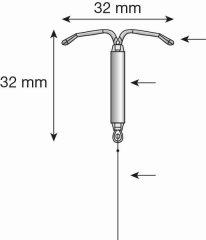
Фигура 1б: ВМС с устройством для введения Левосерт Оне





Фигура 2: Скользящие элементы для введения
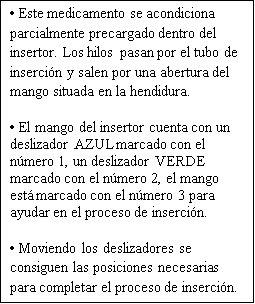



Подготовка к введению
Шаг 1: Открыть стерильную упаковку Левосерта Оне
- Извлеките из коробки запечатанный блистер, содержащий устройство.
- Осмотрите запечатанный блистер и не используйте продукт, если упаковка, устройство для введения или ВМС повреждены.
- Поместите блистер на плоскую поверхность с отсоединяемой крышкой, обращенной вверх.
- Удалите отсоединяемую крышку.
Шаг 2: Извлечь устройство для введения из блистера (фигура 3)
Фигура 3
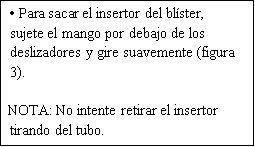
Шаг 3: Полностью переместить скользящие элементы вперед для загрузки ВМС (фигура 4)
Фигура 4
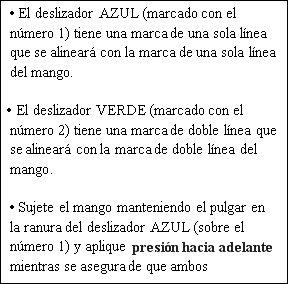



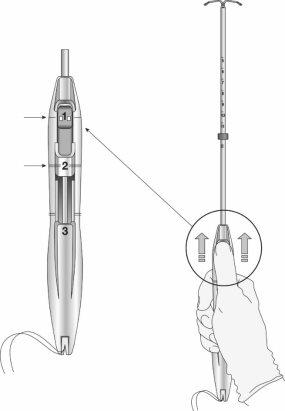
Шаг 4: Загрузка ВМС в устройство для введения
- Убедитесь, что руки ВМС расположены горизонтально (выровнены с горизонтальной плоскостью ручки и маркера); отрегулируйте поворот ВМС при необходимости, используя стерильную плоскую поверхность блистера.
- Поддерживая давление впередна синем скользящем элементе, плавно потяните нити назад, чтобы загрузить ВМС в трубку для введения. Убедитесь, что равномерное напряжение применяется к обоим нитям при их потягивании. Потяните нити вверх или вниз, чтобы заблокировать нитив пазу на основании ручки (фигура 5); необходимо заблокировать нити в пазу, чтобы предотвратить выпадение ВМС из верхней части трубки для введения. Как только нити будут заблокированы в пазу, прекратите их удержание.
Фигура 5: Блокировка нитей в пазу
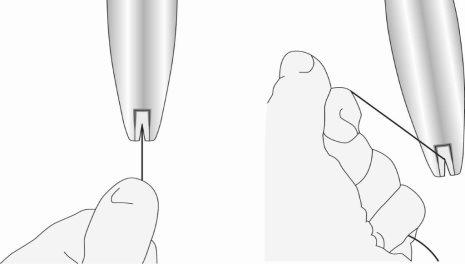
- Как только ВМС загружен, продолжайте поддерживать давление вперед на синем скользящем элементе, чтобы поддерживать правильное положение ВМС.
- Когда он правильно загружен, ВМС полностью находится внутри трубки для введения, с концами рук, образующими полусферическую купол в верхней части трубки (фигура 6, изображение 1).
Фигура 6: Положение ВМС в трубке для введения
Изображение 1


Изображение 2
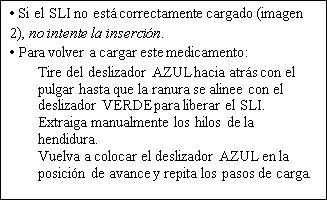
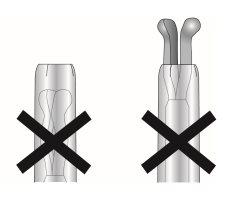
Шаг 5: Регулировка маркера (фигура 7)
Фигура 7


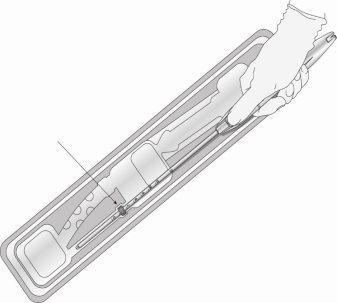
Шаг 6: Введение ВМС в матку (фигура 8)
Фигура 8
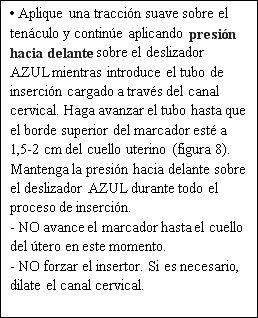


Шаг 7: Освобождение и открытие рук ВМС
Фигура 9
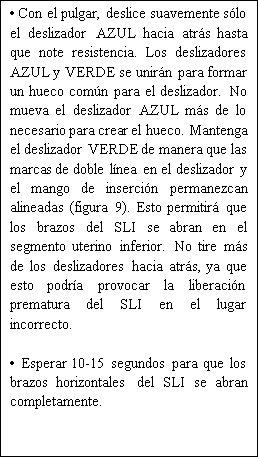


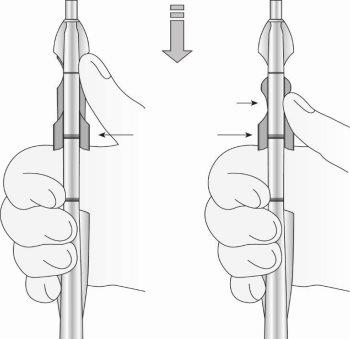
Фигура 10: Перемещение устройства в направлении дна матки
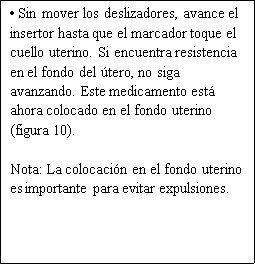

Шаг 8: Освобождение ВМС и завершение процедуры
Фигура 11: Освобождение ВМС из трубки для введения
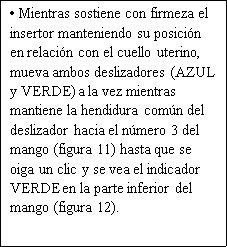

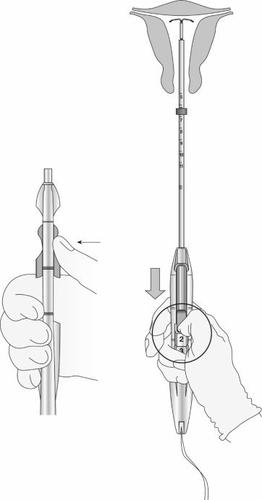
Фигура 12: Видимый зеленый индикатор и освобожденные нити из паза
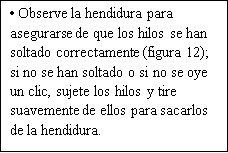
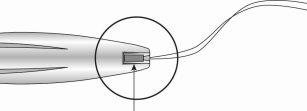
Фигура 13: Обрезка нитей на расстоянии 3 см от шейки матки
|
Введение Левосерта Оне завершено.
Важная информация, которую следует учитывать во время или после введения:
- если подозревается, что ВМС не находится в правильном положении:
- Проверьте введение с помощью ультразвука или другой подходящей радиологической пробы.
- Если подозревается неправильное введение, удалите ВМС. Не повторно вводите тот же ВМС после его удаления.
ВАЖНО!
В случае трудного введения и/или исключительного боли или кровотечения во время или после введения следует немедленно провести физический осмотр и ультразвук, чтобы исключить перфорацию матки или шейки матки. Сам по себе физический осмотр (включая проверку нитей) может быть недостаточным для исключения частичной перфорации. Если необходимо, удалите систему и введите новую стерильную систему.
После введения женщин следует повторно осмотреть через 4-6 недель, чтобы проверить нити и убедиться, что устройство находится в правильном положении. Сообщите о любом случае перфорации матки или трудностей введения через Испанскую систему фармаковигиланса для лекарственных средств для человека: https://www.notificaram.es.
Удаление/замена
ВМС удаляется путем плавного потягивания нитей с помощью пинцета. Использование чрезмерной силы или острых инструментов во время удаления может привести к разрыву системы.
Если нити не видны и обнаружено, что система находится в маточной полости при ультразвуковом обследовании, ее можно удалить с помощью узких пинцетов. Это может потребовать расширения шейки матки или хирургического вмешательства.
После удаления ВМС необходимо осмотреть систему, чтобы убедиться, что она целая и полностью удалена. Во время трудных удалений были зарегистрированы отдельные случаи, когда гормональный цилиндр скользил по горизонтальным рукам, полностью скрывая их внутри цилиндра. Это состояние не требует никаких дополнительных вмешательств после проверки того, что ВМС целый. Выступы горизонтальных рук обычно предотвращают полное отделение цилиндра от Т-образного корпуса.
- Страна регистрации
- Активное вещество
- Требуется рецептДа
- Производитель
- Информация носит справочный характер и не является медицинской рекомендацией. Перед приемом любых препаратов проконсультируйтесь с врачом. Oladoctor не несет ответственности за медицинские решения, принятые на основе этого контента.
- Аналоги ЛЕВОСЕРТ ОДИН 0,02 мг КАЖДЫЕ 24 ЧАСА ВНУТРИМАТЕРОЧНАЯ СИСТЕМА ПРОДОЛЖИТЕЛЬНОГО ВЫСВОБОЖДЕНИЯФорма выпуска: ВНУТРИМАТОЧНАЯ СПИРАЛЬ, 13,5 мг левоноргестрелаАктивное вещество: plastic IUD with progestogenПроизводитель: Bayer Hispania S.L.Требуется рецептФорма выпуска: ВНУТРИМАТОЧНАЯ СПИРАЛЬ, 19,5 мгАктивное вещество: plastic IUD with progestogenПроизводитель: Bayer Hispania S.L.Требуется рецептФорма выпуска: ВНУТРИМАТОЧНАЯ СПИРАЛЬ, 52 мг / начальная скорость высвобождения 0,02 мг каждые 24 часаАктивное вещество: plastic IUD with progestogenПроизводитель: Gedeon Richter Plc.Требуется рецепт
Аналоги ЛЕВОСЕРТ ОДИН 0,02 мг КАЖДЫЕ 24 ЧАСА ВНУТРИМАТЕРОЧНАЯ СИСТЕМА ПРОДОЛЖИТЕЛЬНОГО ВЫСВОБОЖДЕНИЯ в других странах
Лучшие аналоги с тем же действующим веществом и терапевтическим эффектом.
Аналог ЛЕВОСЕРТ ОДИН 0,02 мг КАЖДЫЕ 24 ЧАСА ВНУТРИМАТЕРОЧНАЯ СИСТЕМА ПРОДОЛЖИТЕЛЬНОГО ВЫСВОБОЖДЕНИЯ в Польща
Аналог ЛЕВОСЕРТ ОДИН 0,02 мг КАЖДЫЕ 24 ЧАСА ВНУТРИМАТЕРОЧНАЯ СИСТЕМА ПРОДОЛЖИТЕЛЬНОГО ВЫСВОБОЖДЕНИЯ в Україна
Врачи онлайн по ЛЕВОСЕРТ ОДИН 0,02 мг КАЖДЫЕ 24 ЧАСА ВНУТРИМАТЕРОЧНАЯ СИСТЕМА ПРОДОЛЖИТЕЛЬНОГО ВЫСВОБОЖДЕНИЯ
Консультация по дозировке, побочным эффектам, взаимодействиям, противопоказаниям и продлению рецепта на ЛЕВОСЕРТ ОДИН 0,02 мг КАЖДЫЕ 24 ЧАСА ВНУТРИМАТЕРОЧНАЯ СИСТЕМА ПРОДОЛЖИТЕЛЬНОГО ВЫСВОБОЖДЕНИЯ – по решению врача и с учетом местных правил.



